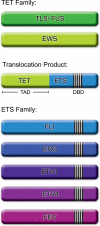Recent advances in the molecular pathogenesis of Ewing's sarcoma
- PMID: 20543858
- PMCID: PMC3555143
- DOI: 10.1038/onc.2010.205
Recent advances in the molecular pathogenesis of Ewing's sarcoma
Abstract
Tumor development is a complex process resulting from interplay between mutations in oncogenes and tumor suppressors, host susceptibility factors, and cellular context. Great advances have been made by studying rare tumors with unique clinical, genetic, or molecular features. Ewing's sarcoma serves as an excellent paradigm for understanding tumorigenesis because it exhibits some very useful and important characteristics. For example, nearly all cases of Ewing's sarcoma contain the (11;22)(q24;q12) chromosomal translocation that encodes the EWS/FLI oncoprotein. Besides the t(11;22), however, many cases have otherwise simple karyotypes with no other demonstrable abnormalities. Furthermore, it seems that an underlying genetic susceptibility to Ewing's sarcoma, if it exists, must be rare. These two features suggest that EWS/FLI is the primary mutation that drives the development of this tumor. Finally, Ewing's sarcoma is an aggressive tumor that requires aggressive treatment. Thus, improved understanding of the pathogenesis of this tumor will not only be of academic interest, but may also lead to new therapeutic approaches for individuals afflicted with this disease. The purpose of this review is to highlight recent advances in understanding the molecular pathogenesis of Ewing's sarcoma, while considering the questions surrounding this disease that still remain and how this knowledge may be applied to developing new treatments for patients with this highly aggressive disease.
Figures


References
Publication types
MeSH terms
Substances
Grants and funding
LinkOut - more resources
Full Text Sources

